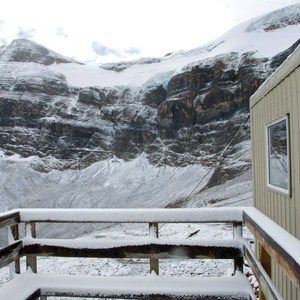Crowfoot Glades is a popular area for running laps. It's terrific for newer skiers or those not looking to stretch their legs too much. The parkway tends to get better snow than areas further south, so often when things are dry in Banff or Canmore, it can be dumping further north. The glades also sit northeast of the Wapta Icefield. With prevailing winds coming from the southwest, dry snow tends to get blown off the icefield, where it gets caught by the treed glades bellow and provides above-average glade skiing for the Rockies. The trees are younger lodgepole pines, so they are tightly packed and hardy. Rockies skiing is all about softshells, and on these runs it's evident that only softshells have the durability to manage the occasional snag. Hardshells have almost no place in the Rockies anyway. The lack of breathability of hardshells and near total absence of wet conditions makes them basically useless except in extreme storms.
The tour trailhead is at the Crowfoot Glacier Lookout located on the Icefield Parkway about 20 minutes north of Lake Louise. The drive is generally pretty good, though in heavy storms the Parkway is not a priority for snow clearance, and the road can get shut down. Be sure to check Parks Canada Road Report before heading out.
The tour begins by dropping down into the valley. It's pretty shallow, so keeping your skins on is an option if you are pretty stable, or don't care about your skins too much. Thick trees give way to wide open waters and you can cross quickly. Head for the trees sitting to the climber's left of the impressive seracs of the Crowfoot Glacier.
Once you get to tree line the route becomes a choose your own adventure. The easiest skin tracks are further to the climber's left beyond the craggy gullies. There is some more open terrain for skiing back down on the climber's right of the gulleys, though you can find good pockets higher up to the southeast. The bowls beneath Bow Peak also have some good runs, but the avalanche risks multiplies because there are plenty of steep and suspect slopes. It's also a wind funnel that tends to be blown into sastrugi.
Avalanche risk is generally pretty low in the trees because the terrain rarely gets that steep. Be mindful of open areas, and remember that avalanches can and do happen even in tight trees.






























Comments
Sign In and share them.